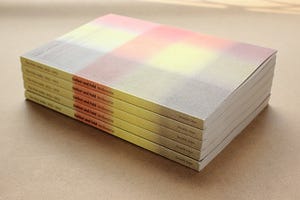How a self-initiated project can change your career.
Personal projects give designers the chance to display their skills to the fullest, where client work may not. I reflect on how my first self-funded book impacted my working life.
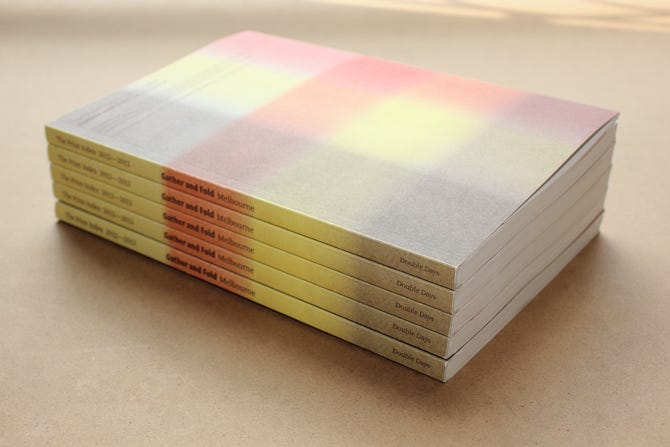
I met Leah Jackson at a pub. The Melbourne-based ceramicist was friendly and through our conversation, I discovered she was also passionate about her craft. She talked about her work, her collaborators, and those in the local art and design community that she admired. I had heard of none of these people, but I wanted to know them. And as a designer new to the city, I had wanted to continue our conversation well beyond its polite conclusion.
The truth was, I was struggling to find my way within the local design community: I was shy, I had little conviction about the work I was doing. I knew wonderful people were close by, but felt I didn’t had the ability to reach out to them. Looking back, this is how powerful self-initiated projects can be: they are the intersection of our own person problems (or passions) with the skills and tools we possess as designers.
And this is how Gather and Fold began: with Leah, and as a project of self-education: a way to access the thoughts and motivations of creative strangers in a city also strange to me.
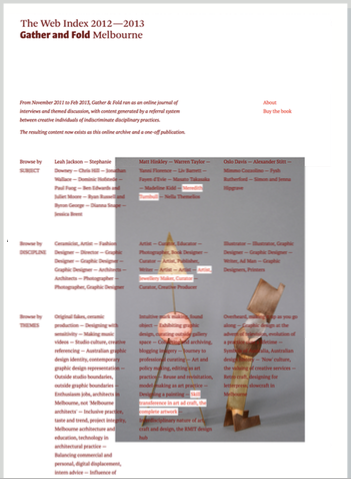
Gather and Fold started as a blog, launching at a time when design blogs were a powerful form of online community sharing. I would interview creatives based in Melbourne about their craft and process. But there was to be a significant differentiator: Because I didn’t really know anybody, I decided to start with Leah, and ask her who I should interview next.
This became the blog’s distinctive ‘referral system’: the creative I interviewed would refer me on (regardless of discipline or level of experience) to the creative to be interviewed next. This meant Gather and Fold became less about myself and something that could be interesting to someone else. The referrals were never random, but completely reliant on human relationships; exploiting pre-existing connections, gaining access to creatives who might otherwise be too shy or hesitant to take part in an interview. It exposed the natural threads and connections that run through the local art and design industry, and was exciting to watch where it led.
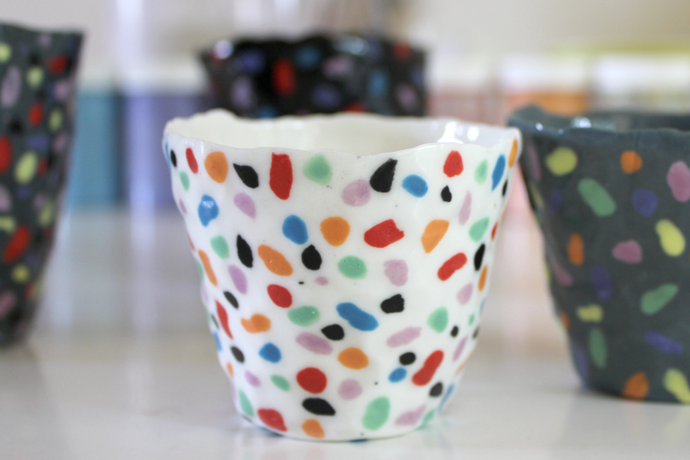
But how did it change my career?
Over the 2 years that Gather and Fold was growing, I was employed full-time as a publication designer, and had started writing design articles for a few magazines. But it was this self-initiated project that I give credit for changing the course of my career (and life).
- It cured my shyness.
‘Networking’ is a cold term, and it is not really what I did, but the blog allowed me to be active on social media and make contact with great people for a good reason. The project was what gave me a reason to talk to my community. Whether it is asking for peer review or feedback, researching or plugging, this project was something I was expert in, at a time when I was still too young to be expert in anything else. - I was able to learn about an entire design ecosystem.
Mainly due to budget, self-initiated projects are cash-strapped. But this is great. I was forced to do everything myself (along with my Double Days co-founder), far above my core design skills. It gave me access to so many important factors associated with working and learning my craft in a more holistic manner. - I was allowed to fuck up.
I never actually screwed-up in an epic way, but there were many small mistakes along the way. Being my own project, it was my money and time on the line, and I found I was far more liberal with it than I was with client’s money. I was more likely to take a risk and more likely to make an error, which meant I learned more. - I learned to contribute.
This point is crucial for me. Gather and Fold was a turning point in my career because I learned that by creating something that gave unsolicited value to people, with no obligation attached, was deeply rewarding. I can list many career-savvy reasons why contributing is awesome (and it certainly has helped me) but the idea of attaching the notion of contribution to all projects, no matter how small, is one step towards running a truly ethical and sustainable practice. It is now the basis through with we run our studio: all our projects are not-for-profit, and are made to offer something to the wider community. - Don’t design every iota of something.
The referral system that was used to curate the interviews taught me an invaluable lesson: don’t try to ‘design’ every tiny detail. You have to leave a bit of space for somebody else to see or feel something of themselves. Chances are, if you are too controlling, you are strangling the spirit of what you are making. The referral system offered results that I could never have produced had I regulated it all myself. As an entire study the content can be dissected thematically, representing something that is closer to truth, rather than how I see things personally. It was an epiphany at the time.
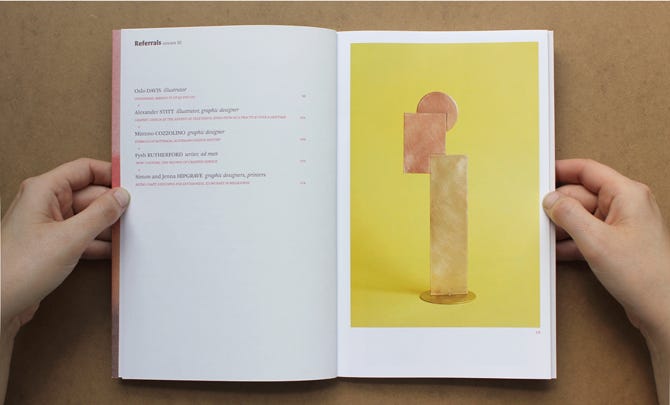
The blog was moderately popular and lovingly supported. When Double Days published the printed version, it sold out. It seemed to exist at just the right time, and capture the Australian design-community’s imagination. I was lucky.
After the project, I had 29 new friends, an active community around me, and invitations to appear on panels and festivals. I was offered the editorship at Australia’s oldest design magazine — a post I accepted and worked at for the following couple of years. How this led to the tech industry and strategic design is another story, but the course of my life changed because I brought together a need I had with a set of tools to solve it.
Occasionally I do a talk or a workshop for students where I am asked design career advice. This article represents my response which has never changed: self-initiate your own projects. Don’t wait for the perfect client or project to come along and give you the opportunity to showcase your worth—create that opportunity for yourself, but remember (and this is crucial) this isn’t a vanity project. Do it for yourself, for others.
Due to the closing down of the Gather and Fold web archive and its publication selling out, we have recently made the book available on our website as a free download. Get your copy here.
Bonnie Abbott is a Melbourne-based strategic designer and researcher, and co-founder of Double Days. She is currently working on its latest project Design Infidelity.
How a self-initiated project can change your career. was originally published in Prototyping: From UX to Front End on Medium, where people are continuing the conversation by highlighting and responding to this story.
